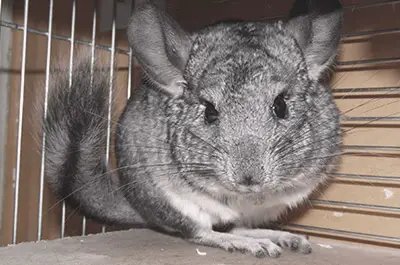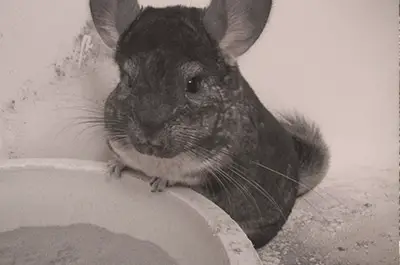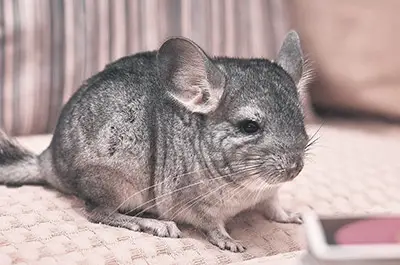Are you thinking of getting a chinchilla as a pet? If so, you need to know how to take care of your chinchilla so that they stay healthy. In this blog post, we will discuss the basics of chinchilla care, including the best way to keep your pet’s cage clean and what kinds of food and water your chinchilla should have.
We will also provide some tips on spotting if your chinchilla is sick and needs veterinary attention. So read on for all you need to know about taking care of your new companion!
What Kind of Cage Does a Chinchilla Need?

A chinchilla’s cage needs to be big enough for them to move around comfortably. Chinchillas are very curious animals and like to explore their environment, so make sure your pet has plenty of room.
Also, be sure that the sides of the cage are not too high for your chinchilla to jump out of. Chinchillas can be injured if they fall from a great height, so try to keep the sides of the cage low.
The cage should be at least two feet wide, one and a half feet deep, and two feet tall. However, the bigger your chinchilla’s cage is, the happier it will be! You should also add shelves and ladders to the cage for your pet to play on. And if you can, you should attach a wheel or ball for your chinchilla to run around in.
Because chinchillas love to chew, they must have their special chewing blocks inside their cage. Chinchillas need at least one large wooden block to chew on, but it’s a good idea to have two.
What should I put on the floor of my chinchilla’s cage?
There are various things you can put on the floor of your pet’s cage. Make sure whatever you choose is safe to chew, though! Good options include wood shavings, aspen bedding, hay, and alfalfa pellets.
You could line the bottom of your pet’s cage with paper towels or linoleum, as chinchillas enjoy the feel of them under their paws. You should never put carpet on the floor of your chinchilla’s cage, as carpet can be dangerous for them.
They are also welcome to eat their hay off the bottom of the cage. Just be sure not to use anything in your chinchilla’s cage that can damage the wood.
How Often Should I Clean My Chinchilla’s Cage?
When you first get your new chinchilla, you should clean its cage and let it air out for at least a day. Then you must clean your pet’s cage every day. Even if you don’t notice anything in the cage, there might be a parasite there that your chinchilla can catch.
Every time you clean your chinchilla’s cage, you should put in new woodblocks and replace old food with fresh. If your pet has a wheel or ball inside its cage, you should clean it with a brush and water every few days.
What is the best type of food for a chinchilla?

A chinchilla needs a balanced diet that is high in fiber and protein. You should give your chinchilla hay all day long, but only let him or her have small amounts of fresh vegetables, lots of freshwaters to drink, and some pellets.
Your chinchilla will love alfalfa hay the best, but you should still have timothy hay in their diet too. Don’t worry if your pet doesn’t seem interested in eating hay at first–it can take a while for your chinchilla to get used to it.
On the other hand, you should only give your pet small amounts of fruits and vegetables–a little bit of healthy food goes a long way! Your chinchilla won’t like dandelions, but they should be able to eat other kinds of leaves.
Remember that your chinchilla’s diet needs to consist mainly of hay, pellets, and water. You should give them as much as they want.
Be careful about what kind of fresh vegetables and fruits you give your chinchilla. Even good foods have lots of sugar and other things that are bad for them inside of them, so you need to limit how much your pet eats.
Vitamins are also crucial for your chinchilla’s diet. You can buy them at any pet store, and they will make sure your pet is healthy and has lots of energy.
What should I feed my baby chinchilla?
If you have a baby chinchilla, you should give them lots of hay and water for the first few weeks. A young chinchilla’s diet is more important than an adult chinchilla’s diet.
You should make sure your new pet is healthy first, and then once they reach the age of three months, you can give your pet fresh veggies. Most chinchillas love dandelions, which are safe for them to eat.
Your little pet will be ready to eat pellets at four months old. You should give them as much hay, water, veggies, pellets, and vitamin pellets as they want, but you should still make sure your pet doesn’t overeat.
Provide plenty of water bottles.
Every chinchilla’s first and most important requirement is water, so you should never run out of fresh water for them. Check both their water bottle every day to make sure your pet is drinking enough.
If you find that your chinchilla isn’t drinking enough, add a little bit of apple juice to the water–it will give your pet more energy, and they should start drinking again.
You should also be prepared for a chinchilla to break or lose its water bottles. If one of them is broken, give your pet another one right away. If one of them is lost or taken away, you should get a new one and clean the old water bottle before giving it to your pet.
Keeping your chinchilla healthy is the most critical part of owning one. Everyone who has a pet wants their animal to be happy for their entire life, but chinchillas are more fragile than most animals.
What is the best way to groom my chinchilla?

Your chinchilla needs to be groomed every day. You should start by taking away anything in their cage that they could get tangled up in. Make sure your pet doesn’t have any tangles in their fur, either.
A chinchilla has many furs, so you will need to brush them every day. Use a soft brush and start at the bottom of their body.
Gently brush every part of their body to get rid of any tangles–you can also help your pet by taking them out of the cage and brushing their fur for a few minutes.
Whenever you take your chinchilla out of its cage, you should use a glove or your hand to pick them up. If you don’t, they might try and run away from you to escape–and that can be dangerous for them.
Chinchillas are delicate, so you shouldn’t hold them for too long. After they are groomed, put them back into their cage.
Your chinchilla’s nails need to be kept short, too. They grow very quickly, so you should buy a nail clipper at your local pet store and clip them when they get too long.
How often should I take my chinchilla to the vet?
You should take your chinchilla to a veterinarian at least once a year for a check-up. If you need to, you can take your pet twice a year to make sure they stay healthy.
If your chinchilla is sick, you should take them to the vet right away. Also, make sure your chinchilla has a check-up if they haven’t been eating well, haven’t been active, or have lost a lot of weight.
How can I play with my pet?
You can let your chinchilla run around the house once they have been weaned and is at least four months old. You should choose a room without too much furniture, and it is also best to stay away from the kitchen because of all the dangers there.
Let your chinchilla out of their cage and play with them using just a few toys. Make sure your pet is supervised because they can get into lots of trouble.
Chinchillas are very active pets that need a lot of exercise. You should let your chinchilla run around for at least one hour a day.
Toys and accessories.

You should play with your pet using toys, especially if they are new to being a house chinchilla. It is best to get them to play with toys before you have unsupervised playtime.
You should also get your pet some accessories–things like tree branches, huts, and hay racks. They will use these items to climb on, play with, and eat from–and they can also help them to get more exercise.
Chinchillas love to play, so it’s essential to have a variety of toys in their cage. You can buy them at your local pet store or online.
If you give your pet a toy they don’t like, take it out of its cage and put it in another room for a day. They might like it the next time you give it to them.
Chinchillas can’t chew on wood, so stay away from toys with wooden parts. They also can’t chew on painted things, so only give your pet safe toys made of metal or plastic.
If you want to put a treat in your pet’s cage, make sure it is safe for them to eat. You should give your chinchilla treats high in protein and low in fat.
Conclusion.
Chinchillas live for 15 years and need a lot of care, but they make great pets. You should keep them in a cage, make sure they are safe and clean, keep their nails short, give them lots of toys to play with, let them run around in a mostly-empty room for a while, and make sure you visit a veterinarian at least once a year.
Comment below and let me know what you think, and answer this question:
Would you like to have a pet chinchilla? Why or why not?
Thanks for reading!

Dive into the insights of Matthew Mansour, a seasoned life coach, fitness guru, and health mentor. With a portfolio boasting over 800 thought-provoking articles, Matthew is passionate about unraveling the intricate layers of the human psyche. His reading choices? Books that shed light on our unique human journey, helping him (and his readers) harness the power of the mind, transforming challenges into stepping stones.
Matthew proudly wears his badge as a self-help aficionado. His mantra? There’s always room to grow, learn, and be inspired. He thrives on gleaning wisdom from pioneers, turning their experiences into valuable lessons for all.
Always on the pulse of emerging trends, Matthew immerses himself in groundbreaking courses and research centered around life coaching and holistic health. Eager to impart his knowledge, he’s here to guide anyone keen on enhancing their life journey.
Beyond his professional persona, Matthew is a devoted animal lover, a proud New Jersey resident, and a doting husband and father. Dive into his self-improvement blog and let Matthew guide you towards a life filled with purpose and passion!
Reviewed By: Joanna Perez and Marcella Raskin
Edited By: Lenny Terra
Fact Checked By: Gabrielle J. Smith
Photos Taken or Curated By: Matthew Mansour